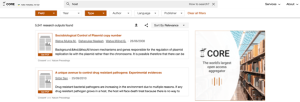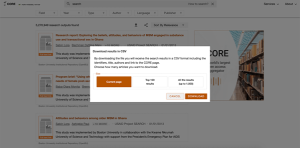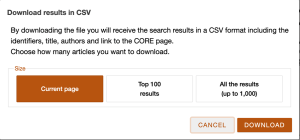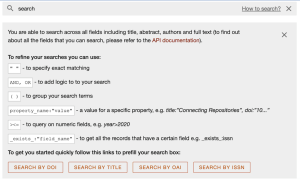CORE has just released a major update to its search engine, including a sleek new user interface and upgraded search functionality driven by the new CORE API V3.0.
CORE Search is the engine that researchers, librarians, scholars and others turn to for open access research papers from around the world and for staying up to date on the latest scientific literature.
CORE constantly evaluates feedback from users and integrates this feedback as a part of the ongoing roadmap for CORE’s continued development. Working with our users and data providers to deliver a consistently improving user experience is a key component in CORE’s ongoing success.
New User Interface
The New User Interface (UI) has been redesigned with a clearer layout and also provides some additional new tools for users including new search filters, sharing and saving options.
Behind the new interface, search uses the new version of the CORE API (a new API to access CORE data). With the API you can perform complex queries to pinpoint highly relevant results for your search. The language is shared so with the new search you have access to the same powerful engine that runs our API. If you are interested in learning more about the features of the CORE API, please see this blog post and this webinar for in-depth details.
Works
One of the key problems CORE is currently addressing is the proliferation of duplicate copies of the same research article. This duplication can occur for a number of reasons. For example CORE may have a version of the same article from the original institutional repository, another from a preprint server (e.g. arXiv.org) and another version from the publisher’s repository,
CORE is tackling this problem by aggregating all known examples of a particular paper into something we call, Works. A Work is the single most recent version of a particular paper, a collection of Works represents all known versions of that paper.
You can view the records that constitute a work and the corresponding Data providers from the Work page when you click on the search result, the list of versions available is on the right hand side.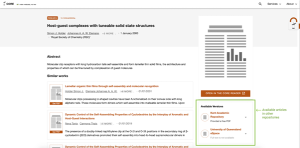 How works looks like:
How works looks like:
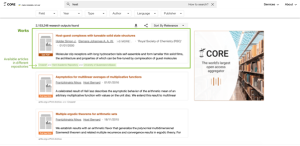
Filtering
Improved filtering. Based on your feedback, we repositioned the filter bar and improved the user interaction to enable a more intuitive experience. We now provide additional query filters that will help your search:: field of study (in broad terms, the topic of a paper), publisher, author, yearIn particular the view for year is the perfect way to see a quick glance on how your search query is evolving over time.
Sorting and Sharing Search Results
Some of the articles in CORE contain only metadata. We have improved the sorting functionality to prioritise records that have open access versions available, either hosted by CORE directly, or via a link to the hosting repository.
Another new feature is the Share button which makes it easy to save your search or to share it online. Image
Download csv allows you to download the search results in a csv for offline analysis of the search results.
It’s easy to master full control of our search interface:. By clicking on the button “How to Search” you can see tips on getting started using many advanced queries to explore the CORE data.
The new CORE search interface and improved functionality are designed to deliver high-quality results quickly, saving you time and frustration when searching for scientific literature. We have an exciting, ongoing development roadmap for CORE. Bookmark or Blog or follow us on Twitter @oacore to keep up with the latest news and progress.

